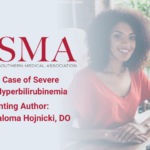Abstract | November 12, 2020
A Unique Case of Severe Neonatal Hyperbilirubinemia
Learning Objectives
- Broaden the differential diagnosis of neonatal hyperbilirubinemia; sitosterolemia should also be considered when administrating total parental nutrition with soybean intralipids to infants with worsening cholestasis. This condition improves with modification of diet.
- Consider sitosterolemia or inadequate plasma sterol metabolism if an infant is demonstrating signs of cholestasis later with the introduction of baby and table foods in a breastfed infant due to the low sterol content in breast milk.
Introduction: Neonatal Hyperbilirubinemia presents as a common reason for admission to the Neonatal Intensive Care Unit. Unconjugated hyperbilirubinemia results from physiologic or pathologic causes and results in approximately 75% of cases. Increased bilirubin load arises from a higher red blood cell mass, decreased red cell lifespan, and deficiency of UGT enzyme in the neonatal period.Causes of pathologic unconjugated hyperbilirubinemia include ABO and Rh incompatibility, red cell or enzyme defects. Finally, the presence of conjugated hyperbilirubinemia is always pathologic and may result from bile formation defects or obstruction.
Clinical Presentation: We present an AGA full term male who developed respiratory distress, hypotension and hypoglycemia after birth. He was noted to have hepatosplenomegaly at birth and his initial total bilirubin at 8 hours of life was 16.1 mg/dl and direct bilirubin 1.1 mg/dl. He was placed on triple phototherapy on DOL 0. He also received three doses of IVIG and two double volume exchange transfusions. His bilirubin continued to increase to a peak total bilirubin of 35.3 mg/dl on DOL 18 and peak direct bilirubin of 26.6 mg/dl on DOL 16.
The infant had a liver biopsy that demonstrated severe cholestatic pattern of injury with bile duct plugging. Infectious disease work-up including cultures taken at time of biopsy and various viral PCR studies were negative.
Diagnosis: A cholestasis panel revealed mutations in four genes associated with sitosterolemia and abnormal plasma sterols.
Discussion: Phytosterols induce cholestasis and can cause direct hepatocyte damage. Intralipids worsen this process due to the high percentage of sterols from steroid alcohols in plants. This infant received intralipids until DOL 18, which likely contributed to his extremely elevated peak bilirubin. Genetics recommended starting formula rich in MCT oil to limit phytosterol concentration. His bilirubin improved and was eventually stable for discharge on DOL 81.

